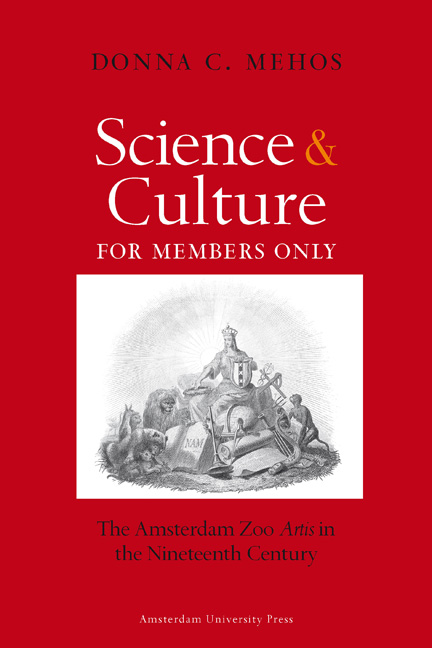Book contents
- Frontmatter
- Dedication
- Contents
- Acknowledgments
- Introduction The Nation and Nature in Middle-Class Culture
- Chapter 1 Structuring a New Generation’s Scientific Society
- Chapter 2 Private Science and the Public Interest
- Chapter 3 Internationalizing Nationalist Science
- Chapter 4 Science Joins Cultural Life
- Conclusion Science, Colonial Expansion, and National Identity
- Appendix: Members of the Artis Board of Directors, 1838-1870
- Notes
- List of Illustrations and Color Plates
- Bibliography
- Index
- Plate Section
Chapter 2 - Private Science and the Public Interest
Published online by Cambridge University Press: 20 January 2021
- Frontmatter
- Dedication
- Contents
- Acknowledgments
- Introduction The Nation and Nature in Middle-Class Culture
- Chapter 1 Structuring a New Generation’s Scientific Society
- Chapter 2 Private Science and the Public Interest
- Chapter 3 Internationalizing Nationalist Science
- Chapter 4 Science Joins Cultural Life
- Conclusion Science, Colonial Expansion, and National Identity
- Appendix: Members of the Artis Board of Directors, 1838-1870
- Notes
- List of Illustrations and Color Plates
- Bibliography
- Index
- Plate Section
Summary
Introduction
In the decades between the founding of Artis in 1838 and the founding of the Municipal University of Amsterdam in 1877, conflict plagued relations between Artis and the city government. Artis's attempts to expand and construct buildings were thwarted by city policies. Charged with protecting the public interest, the Amsterdam municipal government repeatedly defended its refusal to grant building permits, for example, with the argument that the expansion of the private zoological society could not take place at the expense of the public interest. Because the original zoological garden was situated in a non-residential area where the city had previously maintained public pathways and a park-like atmosphere for recreation, municipal authorities argued that the proposed construction of large buildings for the use of zoological society members would result in the public losing this bit of nature in Amsterdam. In turn, the zoo board argued that the expansion of Artis as a significant institution for science was, in principle, in the interest of the public. The arguments made about the public interest were inconsistent and took on rhetorical tones. Both their argumentation and decision-making demonstrate contradictions that defy explanation. The city government apparently took seriously their responsibility to protect the public interest and to maintain a distinction between public and private in these decades of classical laissez-faire governance. The private sector, rather than the city, was responsible for urban development. While studies have shown that the Amsterdam municipality did at times take initiatives and responsibility for city development that were inconsistent with formal laissez-faire policies, this was not the case in its relations with Artis.
National law regulated the organization of Dutch city governments responsible for protecting the public interest. Each city was run by a mayor and aldermen (Burgemeester and Wethouders, or B&W) and a city council (Gemeenteraad). Mayors were appointed by the king, and the aldermen chosen from among the city council members. In the first half of the nineteenth century, the electors of a city had almost no influence on the local government because the patrician city council members themselves elected new councilmen for lifetime memberships.
- Type
- Chapter
- Information
- Science and Culture for Members OnlyThe Amsterdam Zoo Artis in the Nineteenth Century, pp. 35 - 58Publisher: Amsterdam University PressPrint publication year: 2006



